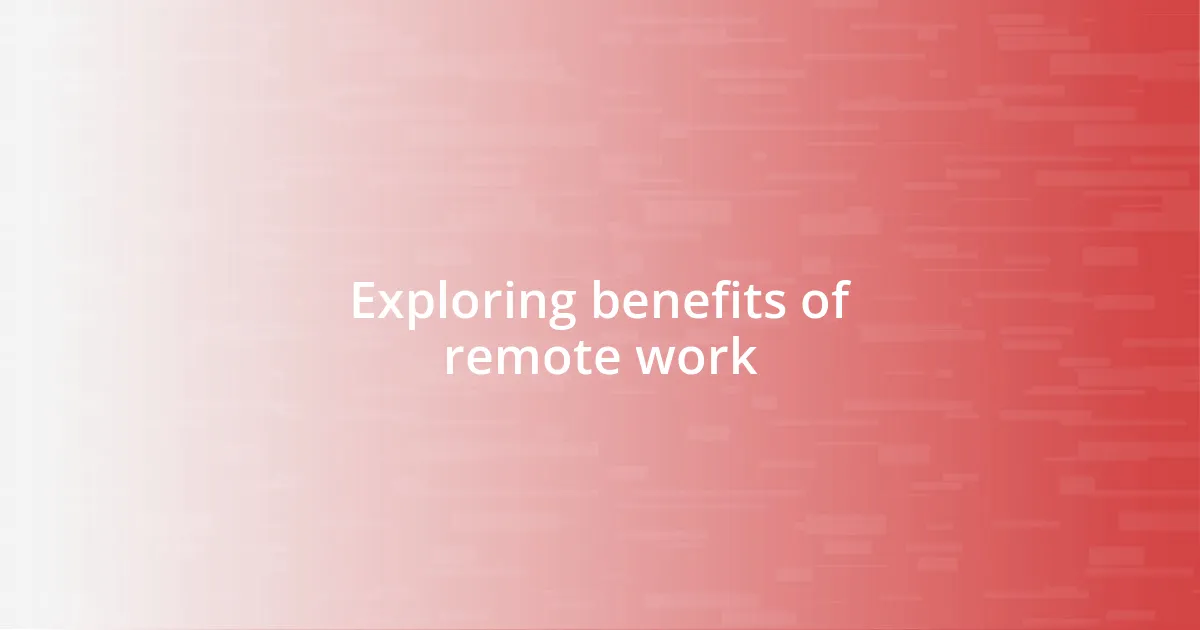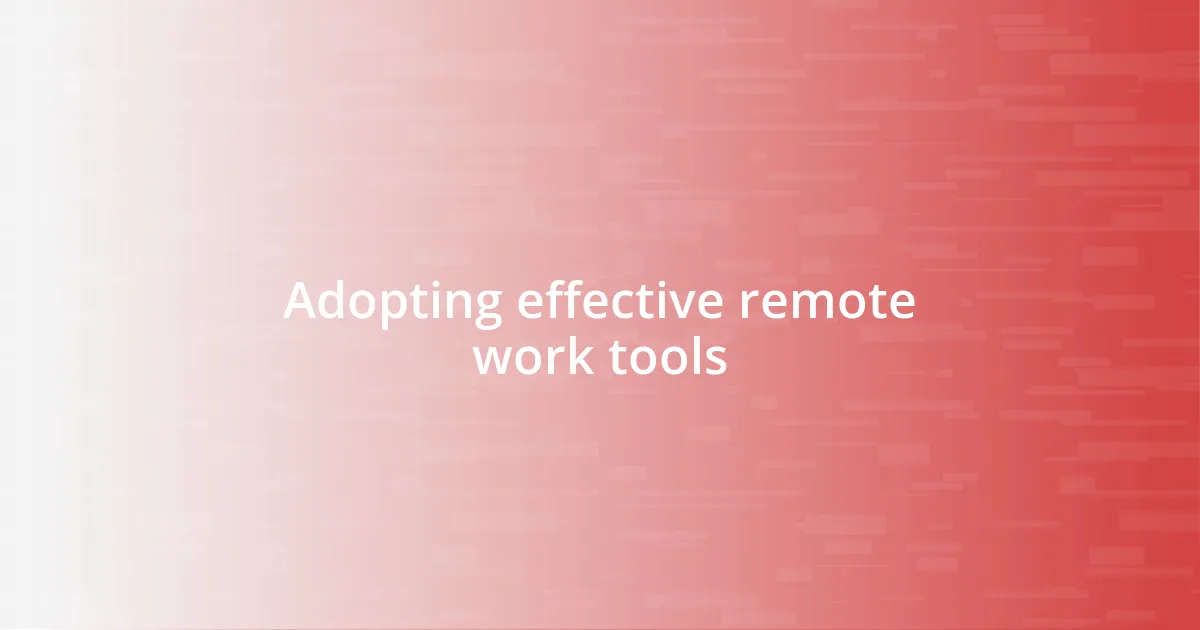Key takeaways:
- Remote work has evolved to enhance flexibility, productivity, and work-life balance, providing significant benefits beyond convenience.
- Challenges such as isolation, communication gaps, and work-life balance must be addressed to improve remote work experiences.
- Effective tools and best practices, like clear communication protocols and regular check-ins, are essential for maintaining team collaboration and morale.
- The future of remote work is anticipated to focus on hybrid models, mental health resources, and skills development for effective digital engagement.

Understanding remote work evolution
The evolution of remote work has truly been a fascinating journey. I remember when I first transitioned to working from home; it felt strange to replace the buzz of an office with the quiet hum of my home. At that moment, I realized that remote work wasn’t just a shift in location—it was a shift in how we connect and collaborate.
As technology progressed, so did our understanding of remote work’s capabilities. I found it enlightening to see how video conferencing tools transformed our conversations; the first time I saw my colleagues on a screen instead of a boardroom was surreal. It raised an interesting question: how can virtual interactions build relationships as effectively as face-to-face meetings? Personally, I’ve grown to cherish those digital interactions, but I sometimes miss the spontaneity of in-person chats.
Reflecting on the rise of hybrid models in many organizations today, it becomes clear that flexibility is key. I often wonder how this blend will shape the future of workplace culture. Wouldn’t it be amazing if employees could choose their work environment based on their moods or tasks? For me, the idea of balancing home and office seamlessly speaks volumes about how we’re adapting to not just survive, but thrive in this new normal.

Exploring benefits of remote work
Remote work offers a plethora of benefits that extend beyond mere convenience. Personally, I’ve experienced a significant boost in productivity since adopting a remote work lifestyle. Without the usual office distractions, I can focus more deeply on my tasks, often finishing work more efficiently. It’s remarkable to see how this increase in focus translates to higher job satisfaction.
One of the key advantages is the flexibility it affords. I remember a particularly busy week when I could structure my work around family commitments, allowing me to attend my children’s school events while still meeting deadlines. This kind of balance is invaluable; it’s like having my cake and eating it too, offering a chance to nurture both my career and my personal life simultaneously. Does anyone else feel this sense of balance is hard to achieve in a traditional office setting?
Moreover, the cost savings associated with remote work can’t be overlooked. Not only do I save on commuting expenses, but I also find myself spending less on lunches and office attire. In today’s world, every penny counts, and these small savings add up to significant benefits. I’ve learned to appreciate how remote work can positively impact both my time and finances.
| Benefit | Personal Insight |
|---|---|
| Increased Productivity | Fewer distractions lead to deeper focus and efficiency. |
| Flexibility | Ability to balance work and personal commitments seamlessly. |
| Cost Savings | Reducing commuting and daily expenses contributes to financial relief. |

Analyzing challenges of remote work
The challenges of remote work can often lurk just beneath the surface, sometimes surprising us when we least expect it. For example, during my early days of remote work, I felt an overwhelming sense of isolation. I remember experiencing days where it seemed my only companions were my laptop and a cup of coffee. Many people, including myself, can find it difficult to adapt to the lack of social interaction that naturally occurs in a traditional office environment.
Here are some key challenges to consider:
- Loneliness and Isolation: Without the daily interactions with colleagues, it’s easy to feel disconnected and remote.
- Communication Gaps: Misunderstandings can arise when relying solely on digital communication, lacking nonverbal cues.
- Work-Life Balance: The lines between work and personal life can blur, leading to longer hours and potential burnout.
- Overreliance on Technology: Technical difficulties can hinder productivity and cause frustration, especially when the tools we rely on fail us.
- Limited Team Collaboration: Brainstorming in person has a unique energy that video calls can rarely replicate, making teamwork feel less dynamic.

Adopting effective remote work tools
Identifying the right tools for remote work can be a game-changer. One of my favorite tools has been Trello, which helps me organize tasks visually. I remember feeling overwhelmed at first with all my projects, but once I started using it, I could see what needed attention at a glance. This clarity boosted my productivity—how satisfying is it to check off completed tasks?
I’ve also come to appreciate tools like Slack for communication. Initially, I thought emails would suffice, but the immediacy of chat channels keeps the conversation flowing. I had my doubts at first; could messaging really replace face-to-face interaction? But I’ve found it actually promotes quick discussions, and I often feel more connected to my team than I did in an office.
Then there are video conferencing tools like Zoom, which have become essential for maintaining visual connections. I never anticipated how much I would miss seeing faces until I attended a virtual team-building session one Friday night. It was a blast, and I realized that these tools aren’t just for meetings—they help us share those little moments that strengthen team bonds. So, have you thought about how these tools might bring your remote team together in unique ways?

Implementing best remote work practices
Implementing best remote work practices begins with establishing clear communication protocols. I once struggled when my team decided to send project updates via an array of messaging apps. It became overwhelming, and I felt like I was always playing catch-up. By streamlining our communication into a single platform, I noticed a significant decrease in confusion and an increase in clarity. Isn’t it amazing how a little organization can lead to such a shift in mood and productivity?
Another critical practice is setting boundaries for work hours. Early on, I would find myself working late into the night, feeling like I had to prove my commitment. However, I learned that maintaining defined work hours not only helped me focus better but also made it easier to switch off and enjoy personal time. There’s something comforting about knowing when the workday starts and ends; it allows us to recharge and return refreshed.
Lastly, regular check-ins can make all the difference in remote settings. I recall a period when we committed to weekly team huddles. Initially, it felt like just another meeting, but soon it became a platform for sharing not only work updates but personal victories, too. This bonding moment lifted everyone’s spirits, reminding me how essential it is to nurture not just productivity but also camaraderie within a remote workforce. Have you considered how simple rituals could transform your team dynamics?

Future predictions for remote work
I believe the future of remote work is leaning towards a hybrid model that balances flexibility with structured office time. Reflecting on my own experiences, I’ve found that having the option to work from home while still connecting in person for team sessions creates a sense of belonging. Isn’t it interesting how we relish that occasional face-to-face interaction after weeks of video calls? It makes collaboration feel more significant.
I also see a rise in the importance of mental health resources in the remote work landscape. I remember the weight of solitude during intense work periods, and I wish more companies had offered mental wellness days back then. As businesses realize the toll remote work can take on employees, they’re more likely to invest in support systems—how can we better foster our emotional well-being in this changing work environment?
Lastly, I think we’ll see an emphasis on skills development tailored for remote engagement. For instance, I recently joined an online course focusing on digital communication strategies. It opened my eyes to how engaging in remote formats can be a skill in its own right. As we evolve, how can we equip ourselves and our teams to excel in a world where digital interaction is paramount?

Enhancing team collaboration remotely
In my experience, utilizing collaborative tools has dramatically changed how teams interact. For instance, when my team adopted a shared digital workspace, I noticed that not only did we share files more efficiently, but we also started communicating ideas with greater enthusiasm. There’s a powerful synergy that happens when everyone’s thoughts and contributions are visible—how often do we miss out on great ideas because they get lost in individual inboxes?
Another strategy I’ve found to enhance collaboration is encouraging informal conversations. I set up a virtual coffee break once a week, allowing team members to chat freely about anything under the sun. It feels refreshing to see colleagues share their personal stories and laughter, creating connections that transcend project deadlines. After all, how can we expect our work relationships to thrive if they’re confined to formal interactions?
Lastly, I believe that recognizing team achievements can foster a stronger bond among remote colleagues. I remember a time when we celebrated a successful project completion with a simple “shout-out” in our group chat. The joy and appreciation sparked from that small act were palpable, making everyone feel valued and motivated for future projects. Don’t you think that those little moments can weave a stronger fabric of teamwork, no matter the distance?















